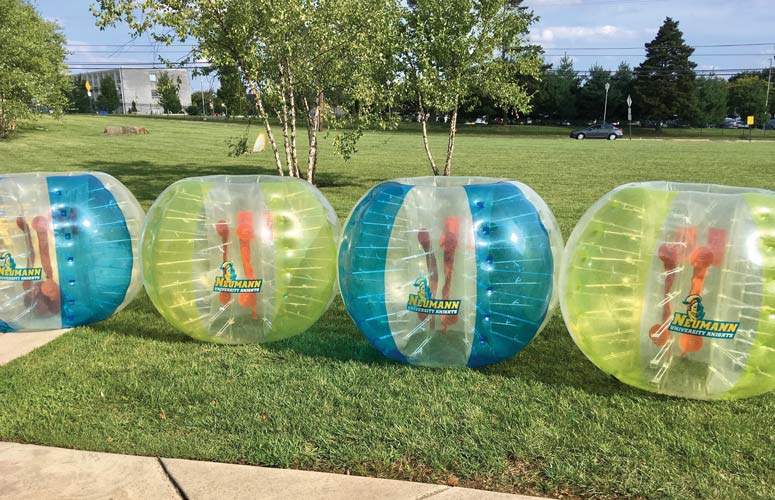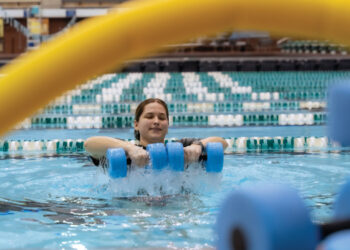To ensure your campus rec department sticks out among the crowd, you want to stay on top of the trendiest and most unique intramural offerings out there. Below, we spoke with different campus rec professionals about their unique programs, how it benefits their rec department and how others can start offering the same programs.
Aqua Intramurals at Brock University
To take advantage of their facility pool, the campus rec department at Brock University developed Aqua Intramurals, consisting of different sports in the pool each week. The sports include inner tube water polo, underwater hockey, volleyball and Ultimate Frisbee.
During inner tube water polo, participants are in inner tubes, instead of treading water, with nets on the pool deck on each side of the pool. Water volleyball and Ultimate Frisbee are also adapted to the pool. It’s a simple way to take an ordinary program and make it unique.
Megan Locker, the intramural and PALS coordinator at Brock University, described underwater hockey as a game of mini-sticks played underwater. “With a weighted puck and mini sticks, participants must score by pushing the puck up against the side of the pool wall in a designated 3-foot wide section,” she said. “Snorkels, flippers and a glove for your hand are suggested equipment.”
Additional equipment for underwater hockey includes hockey sticks, a puck and a net. “We use weighted bricks that are used for swimming lessons, placed three feet apart underwater against the edge of our pool, as our net,” described Locker. “We have two different colors of sticks so you can tell teams apart. We used to use caps that participants wore, but found that was a deterrent from joining the league.”
Your campus rec department may already offer some of these aquatics intramurals, but if underwater hockey would be a new addition, Locker suggests introducing an aquatics intramural or multi-sport league first, instead of jumping right into the sport.
“This way, participants can get a feel for it before having a full league,” she said. “A tournament may also help facilitate this as most people have probably never heard of or tried underwater hockey. You will also have to emphasize where in the pool you are playing, and that you can stand up and take a breath at any point.”
Bubbleball at Neumann University
What started as a rental for an end-of-the-year event at Neumann University has turned into an investment. Bubbleball continues to support the campus rec department and provides unique experiences for students on a regular basis.
“They offer something unique to your program, regardless of your athletic background,” said David Deal, the director of campus recreation at Neumann University. “Anyone can get in a Bubbleball. Our athletic director has been in one, and I’ve been in them multiple times.”

One of the attractive features of investing in Bubbleball for Deal was the customizable feature. “We have six yellow Bubbleballs and six blue Bubbleballs, and they all have the Neumann logo on them,” he described.
While Bubbleball is not offered as a league at Neumann, the program is operated similarly to flag football or soccer, playing twice a week for six or seven weeks. Bubbleball is also available for single-day events. One of the factors to not offering this program as a league was space concerns.
“Make sure, as with any sport or activity, you have the space — whether you’re doing it internally or externally,” elaborated Deal. “Internally, we have a secondary gym that’s surrounded by pads with Mondo and multi-purpose sport flooring. Externally, weather plays a factor of course.”
When using Bubbleball externally, Deal expressed a word of caution when the temperature is warm. “You want short shifts, say three to five minutes,” he said. “My ideal time frame is about five minutes, then rotate them out to someone else.”
Not only do you need to be conscientious of the space to host Bubbleball, but also where to store them so you are not continuously inflating and deflating them. “The ideal situation for someone to operate a full Bubbleball league is to have them stored and inflated somewhere. That way it’s a quicker set up and break down process,” said Deal.
Battleship at the University of Rhode Island
Battleship is a unique offering that has been making its way into many campus rec departments as another option to utilize pools and student engagement. At the University of Rhode Island (URI), battleship is run by intramural sports with the support and collaboration of aquatics.
“We have teams of three in canoes in our instructional pool that is four feet deep, so people who can’t swim can still participate,” described Sean Butler, the coordinator of intramural sports at URI. “Each team gets three buckets and two kick boards, which can act as paddles or shields. Up to six boats participate per-heat, and the goal is to sink your opponent’s boat by throwing water into it.”
For this program, the main items you need are canoes and buckets, but if you do not have a shallow pool available, Butler suggests having life vests and enough lifeguards on shift during the event. “From participant feedback, this can be a pretty tiring event, especially if you are in three to four heats,” he said.
Because this sport requires a lot of energy from participants, it is also offered mostly during events as a two-hour program for roughly 10 to 15 teams. Once the sport gathers a larger following, it can be easier to coordinate more teams and adjust the event time.
Overall, battleship can be a great way to integrate students and staff in a fun and active way. “Get your staff members in the water to help officiate, and help keep boats close to each other so the participants are forced to engage and not just hide in a corner,” said Butler. “Watching people laugh and have fun as they try to outlast everyone else is usually entertaining, not just for the participants, but your staff members. So, you can use it as a way to not only bring participants together, but your staff as well.”
Crate Stacking at Florida State University
At Florida State University (FSU), campus rec offers Crate Stacking events in their gym, putting a twist on the traditional climbing offering. By utilizing the same type of anchors from outdoor climbing and the rafters above the gym, participants begin harnessed on the ground and start stacking crates. Once they can no longer stack from the ground, they begin climbing and are handed crates as they go. The goal is to keep your balance and stack the crates as high as you can.
The benefit? The allure of such a unique program has brought in new faces to the FSU rec center and allows staff to show them all the offerings they may not be aware of. “It’s something different,” said Sean Wilkinson, the coordinator for challenge programs at FSU. “I think that’s a lot of the time what pulls in this small percentage we don’t normally get with our more traditional students, and it’s nice to see new faces and watch them look around the rec and say, ‘Oh, this is what it looks like in here.’”
Supplies:
- 60 industrial-grade
milk crates - Climbing ropes
- Harnesses
- Helmets
- Tarps
- Waiver










